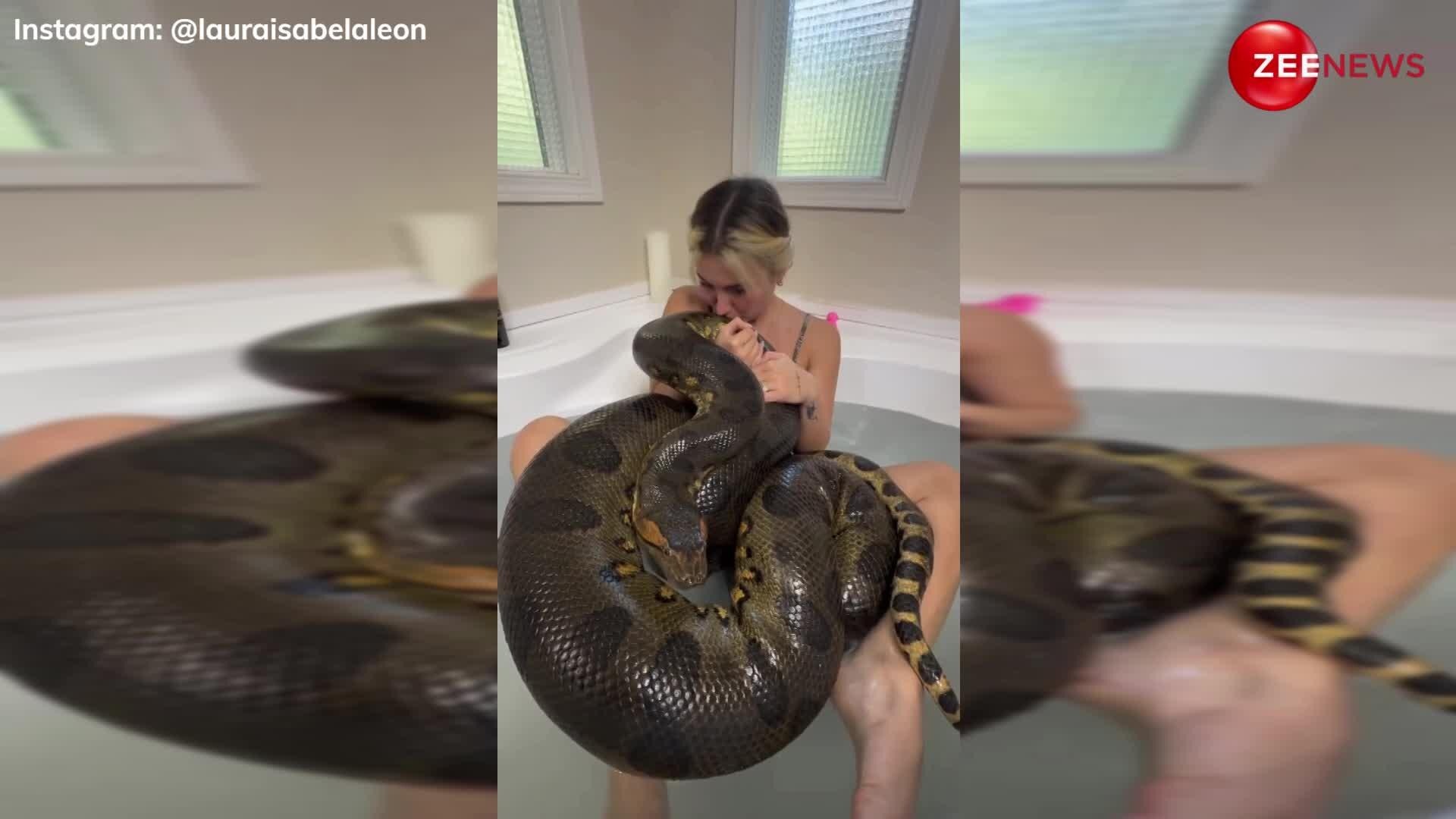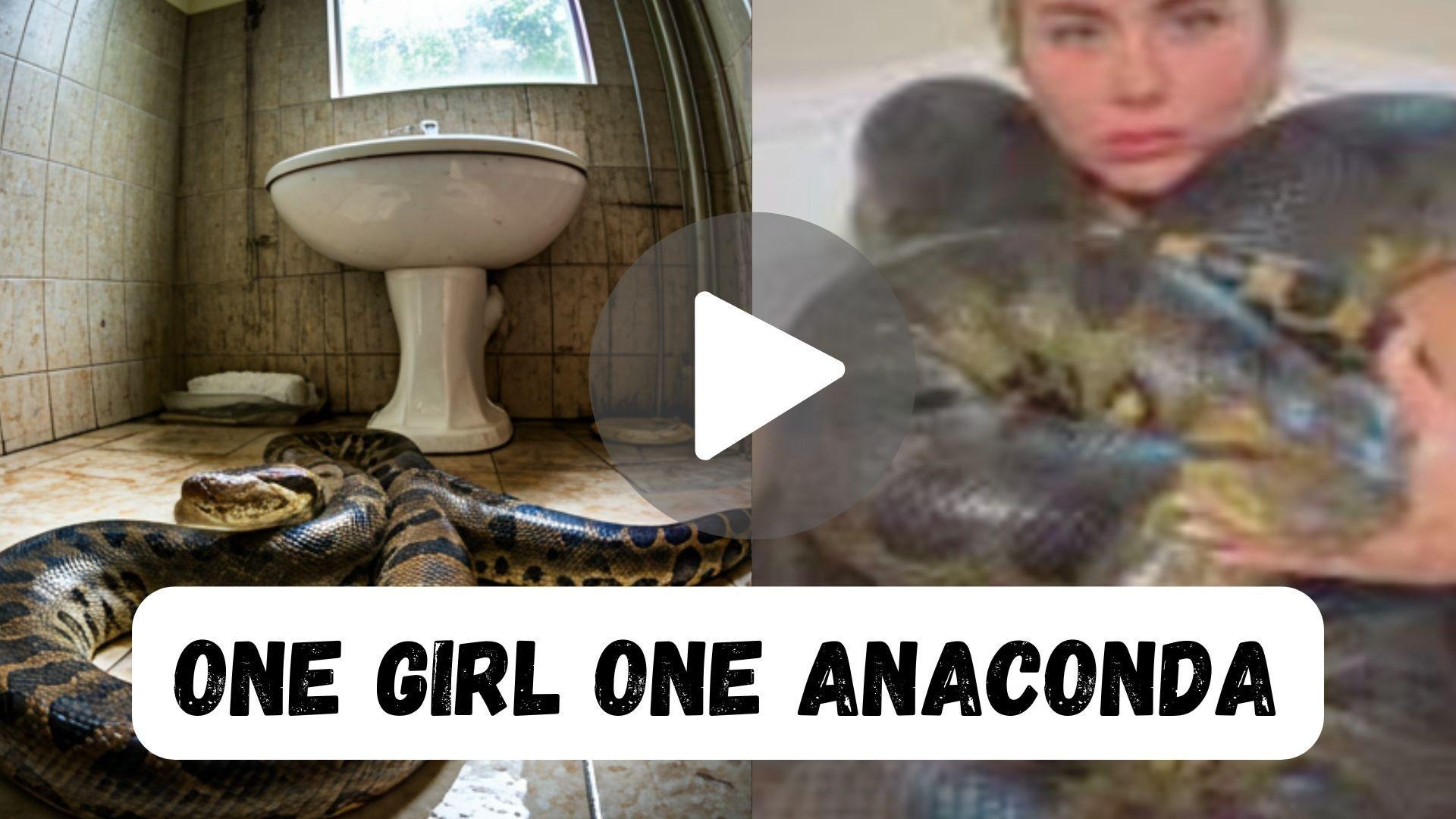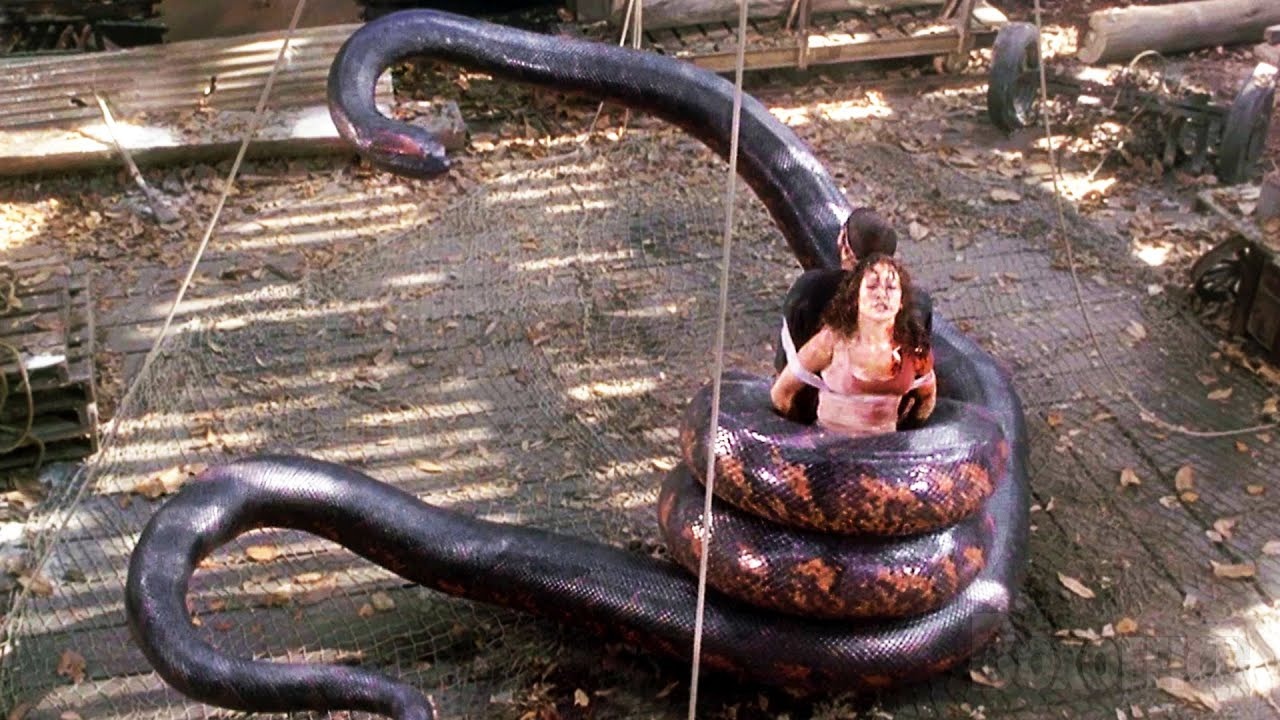One Girl One Anaconda Video The Viral Sensation That Shocked the Internet
In today’s digital age, viral videos have the power to captivate millions within seconds. Among the myriad trends that emerge on social media, extreme encounters—especially those that blur the lines between danger and fascination—often spark intense debate and curiosity. One such phenomenon is the “one girl one anaconda video.” This video, which features a girl engaging in an unusual, intimate encounter with a humongous anaconda, has not only ignited shock and admiration but also raised questions about wildlife interaction, risk perception, and the role of viral media in shaping public opinion.
The video’s blend of awe-inspiring natural beauty and the inherent danger of interacting with a massive snake serves as a perfect case study of how digital content can both entertain and educate. As viewers are drawn in by the element of surprise, they simultaneously confront their own emotions—fear, excitement, and even humor. This article will delve into the many layers of the “one girl one anaconda” trend, exploring its content, origin, impact on wildlife attitudes, and cultural significance. By examining each facet, we will uncover how such content reflects both our fascination with nature and the evolving role of viral media in the modern world.
Description and Analysis of the Video
At its core, the “one girl one anaconda” video is a dramatic portrayal of an extreme wildlife encounter. The footage typically features a young woman fearlessly engaging with an enormous anaconda, captured through quick-panning shots and underscored by dramatic music that heightens the tension. The video’s structure is deliberately crafted to evoke a blend of astonishment and apprehension among viewers.
Visual and Cinematic Elements
The visual narrative of the video is built on rapid cuts and close-up shots that capture both the raw power of the snake and the calm yet determined expression of the girl. The cinematography plays a crucial role in accentuating the contrast between human vulnerability and nature’s untamed force. For instance, the video might begin with an establishing shot of the wild setting, transitioning swiftly to the girl’s interaction with the snake. The use of dynamic camera angles ensures that every twist and turn of the anaconda is highlighted, creating an atmosphere that is both mesmerizing and nerve-wracking.
Production Techniques and Music
Dramatic music accompanies the visuals, adding to the overall intensity of the video. The choice of music is strategic; it not only amplifies the adrenaline rush experienced by viewers but also underscores the surreal nature of the encounter. Quick editing and the use of slow-motion in critical moments allow for a detailed focus on expressions of both awe and caution. Such production techniques transform what might otherwise be a simple wildlife clip into a narrative that resembles a short thriller or action sequence.
The Unusual Interaction
What sets this video apart from typical wildlife documentaries is the element of human daring. The girl’s decision to get up close and personal with the anaconda defies common expectations of caution when dealing with dangerous animals. While many would view such an interaction as foolhardy, the video manages to capture an almost balletic quality in the exchange—merging beauty with risk. The result is a piece of content that leaves viewers oscillating between admiration for the girl’s courage and concern for both her safety and the well-being of the snake.
Analytical Observations
Upon close analysis, one can observe that the video operates on multiple levels. Beyond the surface spectacle, it invites viewers to question why such content goes viral. Is it the shock factor alone, or does it tap into a deeper, primal fascination with the wild? The aesthetic choices—rapid editing, suspenseful music, and close-up visuals—combine to create a sensory overload that mirrors the unpredictable nature of life in the wild. Moreover, by juxtaposing human intimacy with raw nature, the video forces its audience to reconsider the boundaries between civilization and the natural world.
The Origin and Backstory of the Trend
Viral videos rarely appear in isolation; they are part of a broader trend that reflects societal interests and evolving digital narratives. The “one girl one anaconda” video is no exception. Its origins are intertwined with the larger trend of showcasing extreme animal encounters on social media, a trend fueled by the desire to capture nature’s raw, untamed spirit.
The Rise of Extreme Wildlife Footage
Over the past decade, the internet has seen a surge in extreme wildlife videos—from shark encounters to close-up interactions with dangerous reptiles. As mobile technology and high-quality cameras became ubiquitous, everyday users could document unusual and thrilling encounters in the wild. The “one girl one anaconda” video emerged as a natural progression of this trend. It taps into the universal appeal of witnessing the raw power of nature firsthand and the human desire to challenge conventional limits.

Social Media’s Role in Shaping Narratives
Social media platforms such as YouTube, Instagram, and Reddit have played a pivotal role in disseminating these videos. Their algorithms and sharing capabilities allow such content to reach a global audience almost instantaneously. The rapid spread of the “one girl one anaconda” video is a testament to the power of social sharing. What might have started as a local clip recorded in a remote setting soon became a topic of international conversation.
Inspiration Behind the Content
While the exact origins of the video remain somewhat murky, it is widely believed that the content was created with the dual purpose of entertainment and shock value. The creators likely recognized that extreme encounters with nature, especially those that subvert expectations, have a higher chance of going viral. By merging elements of danger, adventure, and a touch of the surreal, the video managed to strike a chord with a diverse audience, from wildlife enthusiasts to adrenaline junkies.
The Broader Cultural Context
The popularity of the video also reflects a broader cultural phenomenon: the growing appetite for experiences that challenge personal boundaries. In an era where curated digital lives often present sanitized versions of reality, raw and unfiltered encounters offer a refreshing glimpse into the unpredictable nature of the world. This desire to push limits—whether physical, emotional, or conceptual—has given rise to a variety of “extreme” content across the web. The “one girl one anaconda” video, with its blend of bravery and risk, is emblematic of this zeitgeist.
Implications for Content Creators
For content creators, the success of such videos underscores the importance of authenticity and daring. It shows that audiences are drawn to content that breaks the mold, even if it defies conventional wisdom about safety and propriety. As a result, many creators now seek to capture experiences that are both exhilarating and boundary-pushing, further fueling the cycle of extreme content that continues to shape the digital landscape.
Impact on Public Perception and Wildlife Attitudes
Viral videos not only entertain—they also have the power to influence public perception, particularly regarding wildlife. The “one girl one anaconda” video serves as a prime example of how sensational content can both educate and misinform viewers about the natural world.
Educating Through Awe and Wonder
For many viewers, encountering a massive anaconda up close is an awe-inspiring experience. The sheer size and strength of the snake can spark a genuine interest in wildlife conservation. By showcasing the beauty and complexity of such creatures, the video has the potential to raise awareness about the importance of preserving natural habitats and protecting endangered species. In this sense, the video can be seen as a double-edged sword—while it entertains, it also educates a public that might otherwise remain indifferent to the marvels of nature.
Misconceptions and Risk Normalization
On the other hand, the video may inadvertently foster dangerous misconceptions. The girl’s fearless interaction with the anaconda might lead some viewers to believe that close contact with wild animals is acceptable or even desirable. This normalization of risky behavior can be problematic, as it undermines the inherent dangers associated with wild animals. It is important for audiences to recognize that what is captured on camera is often an exceptional circumstance and not a recommended practice for everyday interactions with wildlife.

The Dual-Edged Nature of Viral Sensations
The impact of viral videos on wildlife attitudes is complex. While such content can serve as a catalyst for conservation efforts by inspiring wonder and appreciation, it can also desensitize viewers to the potential hazards of wildlife interactions. For instance, repeated exposure to videos that glorify extreme encounters may lead to a desensitization effect, where the public begins to view risky behavior as normal or trivial. This dual-edged nature of viral content highlights the need for balanced discussions and responsible media consumption.
Shaping Conservation Narratives
The conversation around the “one girl one anaconda” video has also sparked debates among wildlife experts and conservationists. Some experts argue that the video, despite its sensational nature, can be harnessed as a tool for wildlife education. By engaging with the public through popular media, conservationists have an opportunity to correct misconceptions and provide accurate information about the behavior and habitat of species like the anaconda. In this way, the video becomes a springboard for broader educational campaigns that promote responsible interaction with wildlife.
Responsible Engagement with the Wild
Ultimately, the video underscores the importance of responsible engagement with nature. While the thrill of an extreme encounter can be captivating, it must be balanced with an understanding of ecological respect and safety. Educators and influencers alike are now challenged to present wildlife in a way that celebrates its beauty without encouraging reckless behavior. The legacy of the “one girl one anaconda” video, therefore, lies not only in its entertainment value but also in its potential to inform and inspire a more nuanced understanding of wildlife.
Emotional and Psychological Reactions: The Rush of Fear, Excitement, and Curiosity
One of the most compelling aspects of the “one girl one anaconda” video is its profound ability to evoke a wide range of emotional and psychological responses. Viewers find themselves caught between exhilaration and trepidation, as the video taps into deep-seated instincts and emotions.
The Adrenaline Rush
For many, watching the video triggers an immediate adrenaline rush. This physiological reaction is tied to the excitement of witnessing something out of the ordinary—a direct encounter with a creature as formidable as an anaconda. The girl’s daring act serves as a catalyst for a surge of endorphins, much like the thrill one might experience while watching extreme sports or adventure documentaries. This burst of adrenaline not only heightens the viewer’s engagement but also creates a lasting memory of the encounter.
Simultaneous Fear and Wonder
While excitement plays a significant role, fear is an equally potent emotion evoked by the video. The idea of interacting closely with a dangerous animal naturally instills a sense of caution. Yet, it is this very fear that amplifies the sense of wonder. The juxtaposition of danger and beauty creates a paradoxical emotional landscape where viewers are compelled to admire the spectacle while simultaneously feeling a pulse of anxiety. This duality is at the heart of what makes the video so unforgettable.

Psychological Curiosity and the Desire for Novelty
Humans are naturally curious creatures, and the video caters to that intrinsic desire for novelty. The unusual subject matter and the boldness of the encounter spark a psychological urge to understand and even emulate the experience. This curiosity extends beyond mere observation—it prompts viewers to question why such interactions occur and what drives individuals to challenge nature in such a direct way. The ensuing conversation often leads to broader discussions about risk-taking, personal bravery, and the allure of the unknown.
Empathy and Relatability
Despite the extreme nature of the content, many viewers also find elements of empathy within the video. The girl’s display of courage resonates on a human level, inviting viewers to reflect on their own experiences of facing fear. In social settings—such as parties or online forums—people often share personal anecdotes about confronting challenging situations, drawing a parallel with the video’s narrative. This sense of shared vulnerability and triumph over fear fosters a communal bond among viewers.
The Role of Social Comparison
Another psychological layer at play is social comparison. When audiences watch someone perform a daring act, they unconsciously compare their own thresholds for risk and adventure. This can lead to a re-evaluation of personal limits and, in some cases, an aspiration to step outside one’s comfort zone. While such comparisons can be inspiring, they also carry the risk of glamorizing dangerous behavior. Thus, the emotional impact of the video is as much about individual psychology as it is about collective cultural norms.
Cultural and Social Implications: Exploring the Intersection of Nature, Adventure, and Humor
The “one girl one anaconda” video is not just a standalone piece of content—it is a cultural artifact that reflects broader societal attitudes toward nature, adventure, and even humor. Its influence extends beyond the realm of simple entertainment, touching upon deep-seated values and beliefs about the natural world and our place within it.
A Reflection of Human-Nature Interaction
Historically, human fascination with wild animals has been woven into the fabric of culture through folklore, art, and literature. The video taps into this long-standing tradition by presenting a narrative that is both primal and modern. It forces viewers to confront their own relationship with nature: Are we mere observers, or can we become active participants in the wild? This question resonates particularly in a time when urbanization and digital life have distanced many from the raw realities of the natural world.
The Allure of Adventure and the Quest for Authenticity
In an era marked by carefully curated digital personas, there is an enduring appeal in witnessing genuine, unscripted moments of human bravery. The girl in the video embodies the spirit of adventure—a willingness to confront danger head-on in pursuit of an authentic experience. This has broader cultural implications, suggesting that in a world saturated with digital filters and staged content, raw and unmediated encounters still hold undeniable value. For many, the video serves as a reminder that real life, with all its unpredictability, can be far more compelling than any polished production.

Humor as a Coping Mechanism
Alongside the serious discussions of wildlife conservation and personal risk, the video also sparks humor and satire. The juxtaposition of the intense, often dramatic footage with the inherent absurdity of the situation creates a fertile ground for memes, jokes, and playful commentary. Humor becomes a way for viewers to process the tension, allowing them to approach a potentially dangerous topic with a measure of levity. Memes that poke fun at the situation, such as quips about “meeting a new pet” or exaggerating the girl’s nonchalance, help diffuse the fear while also reinforcing a shared cultural narrative.
Debates on Ethical Representation and Animal Welfare
Cultural debates surrounding the video also extend into the realms of ethics and animal welfare. Critics argue that while the video is undoubtedly engaging, it may inadvertently encourage reckless behavior and trivialize the potential harm to wildlife. By portraying a dangerous animal encounter in a sensationalized manner, there is a risk of normalizing interactions that could be harmful both to humans and animals. This ethical dilemma has spurred discussions among conservationists, filmmakers, and social media influencers about how to balance entertainment with responsibility.
The Social Dynamics of Virality
Finally, the phenomenon encapsulated by the “one girl one anaconda” video reflects the dynamics of modern virality. In today’s interconnected world, content that provokes strong emotional responses—be it fear, excitement, or humor—is rapidly disseminated across platforms. This phenomenon speaks to a larger trend: the democratization of media, where ordinary individuals can capture and share moments that have global significance. The video, therefore, is not only a reflection of our fascination with extreme encounters but also a testament to the transformative power of digital media in shaping public discourse.
As we reach the end of this exploration into the “one girl one anaconda” video phenomenon, it becomes clear that the content is far more than a fleeting viral moment—it is a mirror reflecting our collective attitudes toward nature, risk, and the digital age. The video encapsulates a spectrum of emotions, from the rush of adrenaline and the thrill of adventure to the sobering realities of wildlife conservation and ethical responsibility.
Balancing Fascination with Caution
The popularity of the video underscores a fundamental human truth: we are drawn to the extraordinary. Whether it is the allure of danger, the quest for authenticity, or simply the novelty of an unconventional encounter, extreme content has the power to captivate. However, as viewers and consumers of media, it is crucial to balance that fascination with caution. Recognizing that what is portrayed on screen is an exceptional case—not a blueprint for everyday behavior—can help mitigate the risk of normalizing dangerous interactions with wildlife.
The Role of Media in Shaping Perceptions
Moreover, the “one girl one anaconda” video highlights the influential role of media in shaping public perceptions about nature. While such content can inspire interest in conservation and spark meaningful conversations, it also has the potential to distort realities if consumed without context. Media creators, therefore, bear a responsibility to provide accurate, balanced portrayals of wildlife interactions. In parallel, viewers must cultivate a critical awareness that not all viral content is meant to be emulated.
A Call for Reflective Engagement
Ultimately, the phenomenon invites us to reflect on our own relationship with the wild. It prompts us to ask: What is it about nature that both terrifies and enchants us? How do our digital experiences influence our understanding of the natural world? As the boundaries between human society and nature continue to blur in our increasingly digital landscape, it is essential to engage with such content in a manner that is both reflective and informed.
Moving Forward in a Digital World
Looking ahead, the “one girl one anaconda” video stands as a reminder of the potent mix of danger, beauty, and humor that defines modern viral media. It calls on content creators to push the envelope in a responsible way, harnessing the power of digital platforms to educate and inspire while maintaining a commitment to safety and ethical standards. For audiences, it offers an opportunity to explore the complexities of human emotion and cultural identity, urging us to appreciate the wild wonders of the world while respecting their inherent risks.
News -
Black Guy FaceTime Prank Video The Hilarious Trend Taking Social Media by Storm
Camilla Araujo Leaked Videos Privacy Breach and Digital Ethics in the Spotlight
Daniel Larson Toothbrush Video 2 The Unexpected Viral Sensation
Justin Mohan Video Twitter Unpacking the Buzz and Its Viral Impact
Watch El Pantera Video Reddit The Viral Sensation Taking the Internet by Storm
Watch Gia Duddy And Will Levis Leak Privacy Breach Sparks Controversy Online
Watch Bakso Jendes The Viral Indonesian Meatball Sensation Taking Social Media by Storm